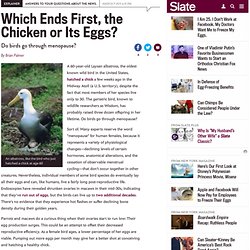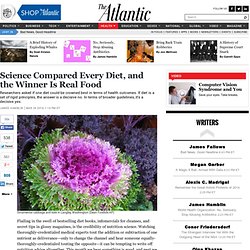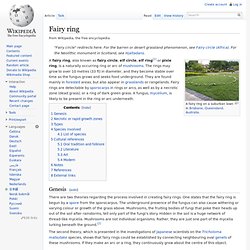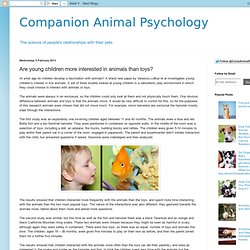

Do birds go through menopause? A 60-year-old Laysan albatross, the oldest known wild bird in the United States, hatched a chick a few weeks ago in the Midway Atoll (a U.S. territory), despite the fact that most members of her species live only to 30.

The geriatric bird, known to wildlife researchers as Wisdom, has probably raised three dozen offspring in her lifetime. Here’s Every Single Animal That Became Extinct In The Last 100 Years (PHOTOS) The number of extinct animals is difficult to calculate and always higher than the estimate.

In some cases, a species is presumed extinct — none have been seen in years — but it’s yet to receive official extinction status by the IUCN. But the important thing to remember is that extinction is not a historical problem — it’s a contemporary issue. Below, take a look at every animal (except insects, which are extremely difficult to catalogue but which you can find here) that went extinct in just the last 100 years. The list is based on research provided by the Sixth Extinction, a website created to “enhance free public access to information about recently extinct species,” and in order of their approximate date of extinction. We’ve included all the animals confirmed extinct by the IUCN, and added a few more declared extinct by other credible individuals and organizations.
Here’s Every Single Animal That Became Extinct In The Last 100 Years (PHOTOS) 'Chameleon' Vine Discovered in Chile. Science Compared Every Diet, and the Winner Is Real Food - James Hamblin. Researchers asked if one diet could be crowned best in terms of health outcomes.

Vermont beekeepers face threat of 'zombie' bees; 1st time parasite found in Eastern US. Jan. 28, 2014: A hive of honey bees is on display at the Vermont Beekeeping Supply booth at the 82nd annual Vermont Farm Show at the Champlain Valley Expo in Essex Jct., Vt.AP Photo/Andy Duback Jan. 28, 2014: A hive of honey bees is on display at the Vermont Beekeeping Supply booth at the 82nd annual Vermont Farm Show at the Champlain Valley Expo in Essex Jct., Vt.AP Photo/Andy Duback.

Amanita hemibapha. 21 More Strange Animals You Didn’t Know Exist. You might think you’ve seen the world over, under, around and through, but there will still be wonders that will make your eyes pop.

Even if you’re a dedicated animal enthusiast, you can’t honestly expect to know all of the 1,367,555 non-insect animal species, that are identified on the face of Earth today! Besides, new animal species might be discovered by the time you finish reading this text, so there will always be some new surprises for us out there. [Read more...] Show Full Text. Is wheat good for you. Fairy ring. Genesis[edit]

Animals that you didn't know existed. Tracking whole colonies shows ants make career moves. Alessandro Crespi Computer tracking of tagged ants demonstrated that workers divided into three specialized groups — but often switched groups as they aged.
Companion Animal Psychology: Are young children more interested in animals than toys? At what age do children develop a fascination with animals?

A brand new paper by Vanessa LoBue et al investigates young children’s interest in live animals. A set of three studies looked at young children in a naturalistic play environment in which they could choose to interact with animals or toys. The animals were always in an enclosure, so the children could only look at them and not physically touch them. One obvious difference between animals and toys is that the animals move. Sifaka. Sifakas (singular "sifaka"; i/ʃɪˈfɑːk/; Malagasy pronunciation: [ˈsifakə̥] ( Sifakas are medium sized indrids with a head and body length of 40 to 55 centimetres (16 to 22 in) and a weight of 3 to 6 kilograms (6.6 to 13.2 lb).

Their tail is just as long as their body, which differentiates them from the Indri. Their fur is long and silky, with coloration varying by species from yellowish-white to black brown. The round, hairless face is always black. Sifakas move by vertical clinging and leaping, meaning they maintain an upright position leaping from tree trunk to tree trunk and moving along branches. Sifakas are herbivores, eating leaves, flowers and fruits. A four to five month gestation period ends with the birth of a single offspring in July. Sifakas hop side-to-side when moving on the ground. Classification[edit] References[edit]
First-Ever Incredible Footage of a Thought Being Formed. Taxa Reference. 'Quadruple helix' DNA discovered in human cells. In 1953, Cambridge researchers Watson and Crick published a paper describing the interweaving 'double helix' DNA structure - the chemical code for all life.

Now, in the year of that scientific landmark's 60th Anniversary, Cambridge researchers have published a paper proving that four-stranded 'quadruple helix' DNA structures - known as G-quadruplexes - also exist within the human genome. They form in regions of DNA that are rich in the building block guanine, usually abbreviated to 'G'. The findings mark the culmination of over 10 years investigation by scientists to show these complex structures in vivo - in living human cells - working from the hypothetical, through computational modelling to synthetic lab experiments and finally the identification in human cancer cells using fluorescent biomarkers.
"The research indicates that quadruplexes are more likely to occur in genes of cells that are rapidly dividing, such as cancer cells. Zoologger: The first solar-powered vertebrate - life - 18 January 2013. Zoologger is our weekly column highlighting extraordinary animals – and occasionally other organisms – from around the world Species: Ambystoma maculatumHabitat: Throughout the eastern USA and parts of southern Canada, leaving other salamanders green with envy When you think about it, animals are weird.
They ignore the abundant source of energy above their heads – the sun – and choose instead to invest vast amounts of energy in cumbersome equipment for eating and digesting food. The Behavioral Sink. Cabinet and the author regret that a previous version of this article omitted its sources. To readers who are interested in learning more about Calhoun's research, we highly recommend "Escaping the Laboratory: The Rodent Experiments of John B Calhoun and Their Cultural Influence" by Edmund Ramsden and Jon Adams, LSE Department of Economic History, 2008, to which this article is indebted.
Reproduction without sex, a liberating future. Aarathi Prasad: Scientists are making progress in techniques for reproducing life without sexExperiments show that sperm and eggs can be generated from male stem cells, she saysPeople will have more choices about when and how to have children, Prasad saysPrasad: Science could help free people from tough choices between work and family Editor's note: Aarathi Prasad is a London-based biologist and science writer and the author of "Like a Virgin: How Science is Redesigning the Rules of Sex". (CNN) -- Last year on the 50th anniversary of the creation of the contraceptive pill its inventor Carl Djerassi spoke of the coming dramatic changes to reproductive options -- of the technologies that will have just as big an impact on society in the 50 years to come.
After sex without reproduction, reproduction without sex. The Psychology of Human Sexuality - Oddities In The History Of Sex Research: Homosexual Necrophilia In The Mallard Duck. As I have discussed in previous blog posts, a number of unusual sexual behaviors have been documented in human beings, from cutting a hole in one’s pants in order to masturbate easily in public to letting insects bite one’s genitals during sexual activity. However, humans aren’t the only ones with curious sexual proclivities—unusual behaviors also occur in the animal kingdom with some frequency. In this post, I’d like to share what is perhaps the most interesting scientific study of animal sexuality I have ever come across [1]. Archives of Toxicology, Volume 85, Number 5. The 7th amendment to the EU Cosmetics Directive prohibits to put animal-tested cosmetics on the market in Europe after 2013.
In that context, the European Commission invited stakeholder bodies (industry, non-governmental organisations, EU Member States, and the Commission’s Scientific Committee on Consumer Safety) to identify scientific experts in five toxicological areas, i.e. toxicokinetics, repeated dose toxicity, carcinogenicity, skin sensitisation, and reproductive toxicity for which the Directive foresees that the 2013 deadline could be further extended in case alternative and validated methods would not be available in time. The selected experts were asked to analyse the status and prospects of alternative methods and to provide a scientifically sound estimate of the time necessary to achieve full replacement of animal testing. Botany of Desire (2009) - full. What Animals Can Change Their Sex?
Many creatures in the sea have evolved to become asexual or hermaphroditic to increase their chances at continuing their species. A type of sea snail known as a sea hare, for example, is shell-less with male genitalia in their fronts and female genitalia behind them. Another ocean dweller is the slipper limpet, which is male while swimming around freely, but changes to female when on rocks. The reason for this change is that the male swimming by a female on a rock is readily able to mate. That same male, however, could turn female if another limpet lands on top of him while he mates with the female. Then there are the hamlets, small fish of the tropics that simultaneously take on both the male and female roles when mating, shifting from one sex to the other in under 30 seconds.
Common parasite may trigger suicide attempts. JCBDataViewer - a TEM image of a 5 dpf zebrafish embryo sagittal section. You can use the "Rendering Details" dialog box to change the settings for viewing this image. To change the color displayed for a channel, click on the color box at the right, which opens the "Choose Color" dialog box. You can choose the color using the interactive features at the top. Hex color codes can be input in the text box. Preset colors can be selected at the bottom. Changes take effect when you click "Apply". Ahaetulla nasuta. The green vine snake (Ahaetulla nasuta), is a slender green tree snake found in India, Sri Lanka, Bangladesh, Burma, Thailand, Cambodia and Vietnam. Animals That are Immortal or Long-lived Animals with "Negligible Senescence". didn't know W/O - Writer's Corner: General Non-Fiction.
DNA Barcoding the Native Flowering Plants and Conifers of Wales. We present the first national DNA barcode resource that covers the native flowering plants and conifers for the nation of Wales (1143 species). Study Reveals Secret of Zebrafish. Tiny chameleons discovered in Madagascar. The zombie-ant fungus is under attack, research reveals. New 'Map of Life' project aims to show distribution of all animals, plants on planet. A research team involving Yale University and the University of Colorado Boulder has developed a first public demonstration version of its "Map of Life," an ambitious Web-based endeavor designed to show the distribution of all living plants and animals on the planet. The demonstration version allows anyone with an Internet connection to map the known global distribution of almost 25,000 species of terrestrial vertebrate animals, including mammals, birds, amphibians, reptiles and North American freshwater fish.
The database, which continues to expand, already contains hundreds of millions of records on the abundance and distribution of the planet's diverse flora and fauna. Map of Life. Scientists discover enzyme that could slow part of the aging process in astronauts. Monster Bug Wars: When Tribes Go To War : Videos. Divers can talk to dolphins, perhaps aliens, with new device. Watering plants with blood. Fossilized pollen unlocks secrets of ancient royal garden.